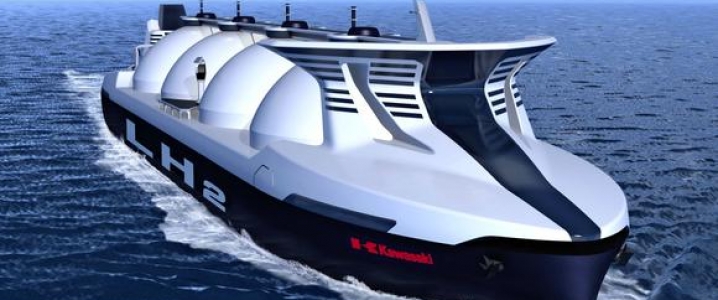Resource-poor Japan has stepped up the search, research, and development of new energy sources following the Fukushima disaster in 2011. In the wake of the accident, Japan shut down almost all its nuclear reactors, and has spent billions of US dollars more on imports of oil, coal, and liquefied natural gas (LNG) since then.
A large LNG and coal exporter close to Japan’s shores, Australia, now aims to export hydrogen—a renewable energy source to help fuel Japan’s ambitions to boost the use of hydrogen in power supply and hydrogen fuel cell powered vehicles.
Hydrogen can be produced with excess renewable energy that would otherwise be wasted, and transported like natural gas, the Australian Renewable Energy Agency (ARENA) says, noting that two Australian projects are already being investigated with the goal of exporting hydrogen to power the 2020 Tokyo Olympics.
Japan—the world’s biggest LNG importer and among the top four coal and oil importers—used to generate 27 percent of its power from nuclear reactors before the Fukushima disaster. Following the accident, Japan shut down all its 54 nuclear reactors to reassess their safety, and has restarted only a few of them so far. Public opposition to nuclear energy is creating uncertainty about how much nuclear generation capacity Japan will restore. Japan spent an additional annual average of around US$30 billion for fossil fuel imports in the three years after the Fukushima accident, according to EIA estimates. Related: Oil Prices Inch Higher As Sanctions On Iran Kick In
So Japan is boosting the search for new—non-fossil fuel—sources of energy. It is one of the pioneers in hydrogen technology, with Toyota for example expanding mass production of fuel cell stacks and of high-pressure hydrogen tanks as it aims to boost sales of fuel cell electric vehicles (FCEVs).
Japan wants to build a ‘hydrogen society,’ and earlier this year, Japanese carmakers Toyota, Nissan, and Honda teamed up with investors and infrastructure developers to create Japan H2 mobility in order to accelerate the strategic deployment of hydrogen stations in Japan.
As Japan advances its ‘hydrogen society’ vision and wants to have hydrogen power as the lasting legacy from the 2020 Tokyo Olympics, Australia is positioning itself to export hydrogen or cooperate with Japanese firms in pilot projects for hydrogen production.
“Today Australia exports approximately three quarters of the energy it produces, in the form of coal and gas. As demand for these resources cools over coming decades, we want our renewables industry to be ready to provide the energy to supply the world’s future needs,” ARENA CEO Ivor Frischknecht said last week.
“ARENA is supporting innovation across the hydrogen supply chain, aiming to make renewable hydrogen commercial and competitive, both here and around the world,” Frischknecht noted.
Australia’s state Queensland, for example, is backing hydrogen research for renewable fuel source, with the aim to export hydrogen, including in Japan. Related: The Key Oil Price Driver By 2020
“Queensland is well placed for hydrogen production with access to feedstock such as water and solar power, existing gas pipeline infrastructure, access to export ports and access to domestic and international markets,” Queensland Premier Annastacia Palaszczuk said during a trade mission to Japan in May.
Another Australian state, Victoria, is supporting a pilot project that will test the production of liquefied hydrogen for use in fuel cell electric vehicles and power generation. The Hydrogen Energy Supply Chain (HESC) project will convert brown coal from the Loy Yang mine of Australian utility AGL into hydrogen at an adjacent site and then transport the gas by road to a liquefaction terminal at the Port of Hastings, for shipment to Japan. The project—backed by the State Government of Victoria, the Australian government, and the Japanese government—is led by Kawasaki Heavy Industries (KHI) and includes leading Japanese energy and heavy industries corporations J-Power, Iwatani, and Marubeni Corporation, as well as oil supermajor Shell.
ADVERTISEMENT
If the current projects turn out successful, the energy trade between Australia and Japan may start to include not only coal and LNG, but also a renewable energy source—hydrogen.
By Tsvetana Paraskova for Oilprice.com
More Top Reads From Oilprice.com:
- China’s Oil Futures Jump To Record High
- Goldman Sachs Expects “Very, Very Tight” Oil Market
- Pakistan: Exxon Is Close To Making A Mega Oil Discovery



















Even with the advances made in hydrogen technology over the past 25 years, there are still many challenges to be overcome before FCVs can compete in the market with current vehicle technology. The most significant challenge is the cost and durability of the fuel cell system.
Another challenge is that the numbers of FCVs sold and out on roads worldwide is quite small. Only 1,074 FCVs were sold in the US during 2016. The numbers for Europe are even much smaller.
Experts estimate it will take 40 years or more before hydrogen has any meaningful impact on gasoline consumption or global warming.
The concept of Japan building a ‘hydrogen society’ is not new. Icelandic professor Bragi Arnason of Reykjavik University whom Newsweek magazine nicknamed as ‘Professor Hydrogen’ has had the aspiration of converting Iceland into a ‘hydrogen economy’ years ago.
I had the great honour of meeting Professor Arnason in Reykjavic on the 16th of October 2007 after which Professor Arnason invited me to give a lecture on Peak Oil at the University. He explained to me that his hydrogen research and future plans aim at converting Iceland into a country where all energy consumed comes from renewable energy sources. He said that if this could be realized in the next 30-40 years, Iceland will be totally independent from imported fossil fuels. But then when compared to Japan, Iceland is a drop in the ocean in economic size.
Dr Mamdouh G Salameh
International Oil Economist
Visiting Professor of Energy Economics at ESCP Europe Business School, London